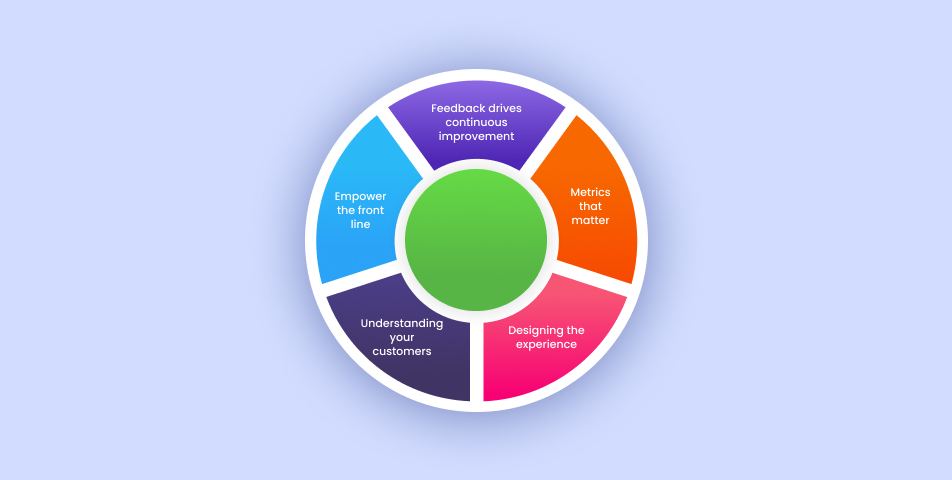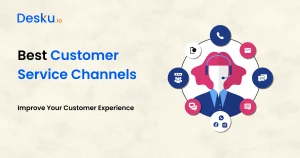Customer-Centric Brands are Gaining 60% more profits because of their relentless focus on creating amazing CX.
A customer-centric company focuses on meeting the needs and surpassing the expectations of customers, to build lasting relationships and loyalty.
In this article, we will explore what is a customer-centric company, examples, 9 customer-centric strategy best practices, the importance of a customer-focus company, how to build customer-centric company culture as well as relational and transactional service models in a customer-centric company.
Key Takeaway :
A customer-centric company is an organization that places its customers at the root of its business plan, aiming to provide a favourable customer experience and meet the expectations of its customers throughout the entire journey. To build a customer-centric company, businesses should focus on deep understanding of customers, putting customers at the center, personalization and customization, effective communication channels, employee training and empowerment, continuous feedback loop, proactive customer support, loyalty and rewards programs, and measuring and analyzing metrics.
What is a Customer-Centric Company?
A customer-centric company is an organization that places its customers at the root of its business plan. The main aim of a customer-centric company is to provide a favourable customer experience and meet the expectations of its customers throughout the entire journey.
This customer-focused strategy not only fosters loyalty and satisfaction but also enhances overall business success and competitiveness in the market.
9 Best Practises: Customer-Centric Strategies
Creating a customer-centric strategy is essential for businesses aiming to build strong customer relationships and foster long-term success.
Here are some best practices to develop an effective customer-centric company:
1. Deep Understanding of Customers
Begin by gaining a profound understanding of your target customers. Conduct market research, analyze demographics, and actively listen to customer feedback to identify their needs, preferences, and pain points.
2. Put Customers at the Center
Place the customer at the centre of all decision-making processes, from product development to marketing strategies. Ensure that every aspect of your business aligns with meeting customer expectations.
3. Personalization and Customization
Tailor your products, services, and interactions to suit individual customer preferences. Embrace personalization techniques to create unique and memorable experiences for each customer.
4. Effective Communication Channels
Offer multiple communication channels to make it easy for customers to reach out and interact with your brand. Promptly respond to inquiries and provide proactive updates when necessary.
5. Employee Training and Empowerment
Invest in comprehensive training programs for employees, focusing on customer service skills, empathy, and problem-solving. Empower your team to make decisions that prioritize customer satisfaction.
6. Continuous Feedback Loop
Establish a robust feedback mechanism to collect customer insights regularly. Actively use customer feedback to improve products, services, and overall customer experience.
7. Proactive Customer Support
Anticipate customer needs and address potential issues before they escalate. Offer proactive support through informative content, self-service options, and timely assistance.
8. Loyalty and Rewards Programs
Implement Customer loyalty programs to reward and recognize loyal customers. Offer exclusive perks, discounts, or personalized offers to enhance customer retention.
9. Measure and Analyze Metrics
Define key performance indicators (KPIs) to measure the success of your customer-centric strategy. Analyze data regularly to track progress and identify areas for improvement.
Examples: Customer-Centric Comapanies
Several companies have successfully implemented customer-centric strategies and achieved remarkable results.
Amazon

Amazon is known for its relentless focus on customer satisfaction.
Amazon’s obsession with delivering a seamless online shopping experience, fast delivery, and exceptional customer service has made it an e-commerce industry leader.
Their commitment to a customer-centric company is evident through the customer reviews and ratings system.
They value customer feedback, which helps others make informed purchasing decisions.
Amazon’s personalized recommendations feature uses advanced algorithms, enhancing the customer experience based on browsing and purchase history.
Zappos
Another example of a customer-centric company is Zappos, a renowned online shoe retailer.
Zappos has built a reputation for its customer-centric culture, going above and beyond to deliver unparalleled customer service.
Their reputation is built on delivering unparalleled customer service, going above and beyond to win customer hearts.
Zappos understands that trust and exceptional experiences foster customer loyalty.
They prioritize creating positive emotional connections through personalized interactions and delightful surprises.
Hilton Hotels & Resorts

Hilton Hotels & Resorts is an exemplary customer-centric company that has established itself as a beacon of hospitality in the hotel industry.
Hilton, a leading hospitality brand, deeply commits to customer satisfaction.
They craft a guest experience that revolves around understanding and catering to unique needs and preferences.
By actively listening to customer feedback, Hilton implements improvements to enhance the overall guest experience.
Through online reviews, surveys, and direct communication, they consistently seek insights to exceed expectations.
Examples like Amazon, Zappos, and Hilton Hotels and Resorts demonstrate the tangible benefits of prioritizing the customer experience, making them leaders in their respective industries.
Why Company Need to Be Customer-Centric?
A Customer-centric is essential for a business to achieve sustainable success and growth. It aims to deliver customer satisfaction and understand what their customer needs.
Let’s know the reasons for a company to be customer-centric to make the customer experience better.
- Developing a customer-centric company starts with understanding customer orientation.
- It involves putting the customer at the centre of all decision-making processes, from product development to customer service.
- Prioritizing customer needs enhances satisfaction, loyalty, and revenue.
- Customer focus goes beyond good service; it requires understanding and anticipating customer needs.
- Gaining insights into customer desires, pain points, and motivations is crucial.
- Understanding customer needs is the foundation for a customer-centric strategy.
Example: A skincare company conducts market research to discover customer preferences for natural, cruelty-free, and sustainable products, aligning their offerings accordingly.
How to Build a Customer-Centric Company Culture?
One of the ways of implementing the customer-centric company culture is to foster it, but how can you do that? It is simple!
- Fostering Empathy: Key to Customer-Oriented Culture
- Going Above and Beyond The Power of Exceptional Follow-Up
- Hiring and Training for Customer-Oriented Success
- Streamlining the Customer Experience: Don’t Put the Burden on Them
- Setting Standards: A Foundation for Customer Orientation
- Achieving Company-Wide Alignment: The Key to Success
- Knowing Your Customers: What Truly Matters to Them
Recommended Article:3 Customer Success Plan Templates and Implementation in Business
Relational vs Transactional Service Model
The Relational vs. Transactional Service Model is a concept used in customer-centric companies to differentiate between two approaches to customer service and engagement.
Both models have different focuses and objectives, but they can complement each other in providing a holistic customer experience.
| Service Model | Relational Service Model | Transactional Service Model |
|---|---|---|
| Focus | Building strong, long-term relationships | Efficient handling of individual interactions |
| Goal | Foster trust, loyalty, and emotional connections | Provide effective and quick service |
| Approach | Create personalized experiences | Transaction-based interactions |
| Customer Interaction | Emphasizes emotional connections and understanding | Focuses on efficient problem-solving and transactions |
| Long-term Relationship | Central to the strategy | Not the primary focus |
Key Characteristics of Relational Service Model
The relational service model aims to retain customers and companies use this model to prioritize customer needs. The below characteristics will help you in delivering adaptable solutions.
Personalization:
- Collect and use customer data for personalization.
- Offer personalized recommendations and solutions.
Customer Engagement
- Engage with customers beyond transactions.
- Personalized emails, follow-up calls, and social media interactions.
Proactive Support
- Anticipate customer needs and assist.
- Proactively reach out to help before customers ask.
Long-term Focus
- Aim to retain customers for loyalty and repeat business.
Example: A software company using the Relational Service Model might assign dedicated account managers to each client. These managers understand the client’s unique requirements and regularly check in to provide ongoing support, updates, and customized solutions.
Key characteristics of Transactional Service Model
The purpose of the transactional model is to deliver efficient and satisfying services that serve the immediate needs of customers. The following characteristics will help your business in emphasizing quick and effective resolution.
Efficiency
- Handle interactions quickly and effectively.
- Optimize processes for speed and accuracy.
Standardization
- Use standardized responses and processes.
- Resolve immediate concerns or issues.
Issue Resolution
- Focus on resolving immediate customer issues.
Short-term Focus
- Prioritize immediate transactions and needs.
- Less emphasis on building long-term relationships.
Example: A retail store using the Transactional Service Model ensures that customers have a smooth checkout process, with well-trained cashiers who can efficiently handle transactions and answer common questions about products.
What’s Your Take on Customer-Centric Company?
Customer-centric brands like Amazon, Zappos, and Hilton Hotels & Resorts are excelling due to their unwavering focus on creating exceptional customer experiences. Putting customers at the root of their strategies has led to incredible rewards, including increased profitability and determined customer loyalty.
Embracing these customer-centric company approaches can help businesses thrive as leaders in their respective industries.





